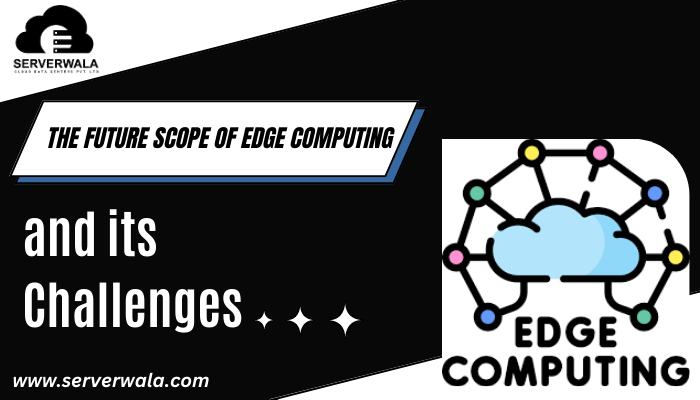Introduction
Have you ever thought about processing data closer to its source?
This is the purpose of edge computing, which aims to minimize the distance between the data source and the processing component.
Through this technique, the time for data travel is greatly reduced. Nevertheless, there is a plethora of factors that can influence the edge computing process that you should be aware of. In this article, we have provided all the necessary details about edge computing, including the challenges of edge computing. We will also talk about the bright future of edge computing. It’s worth noting that this technology is still relatively new compared to others, so keep reading for a comprehensive understanding.
What is the Future of Edge Computing?
In today’s fast-pacing life, time is the most essential commodity. Everyone is on the lookout for anything that can provide quicker results, and edge computing is a technology that fits the bill.
It is designed to enhance decision-making and data transmission speed, making it an increasingly popular choice for businesses and individuals alike.
To better comprehend the future of edge computing, let’s consider a smart water heater for a pool that relies on temperature data.
In the past, the water heater would collect data and send it to a cloud server for processing, which would then decide on heating the water.
However, with the advent of new technology, data processing has been relocated to a local source nearer to the water heater, resulting in faster decision-making.
This example is a simple explanation of edge computing, which is expected to experience an upsurge in demand in the future due to the growing popularity of the Internet of Things, 5G networks, and advancements in AI.
Features of Edge Computing
Latency
Latency refers to the time delay that occurs when information is transmitted over a vast distance on a network that’s not strong enough.
Fortunately, edge computing provides a viable solution to this problem by making use of a local data collection source on a powerful network.
This approach helps to eliminate the travel time required for data to be transmitted over long distances, resulting in significantly reduced latency levels and an improved user experience.
Network Bandwidth
Have you ever considered the consequences of using up too much of your network bandwidth for massive data transmissions? This can lead to a decreased grade of your network’s performance. Edge computing has the perfect solution to this problem by sending most of the data to a local server. This reduces the amount of complex data that is sent over the network, ultimately reducing the load on your bandwidth.
Scale
One of the key advantages of edge computing is its impressive scalability. This is because the number of edge devices that can process data at a local level can easily be increased or decreased depending on the system’s specific needs. What’s more, location is not a limiting factor when it comes to edge nodes. This means that data can be processed closer to the place where it was generated, leading to faster response times and better efficiency.
Data Accumulation
A significant advantage of utilizing this innovative technology is its ability to streamline the procedure of collecting data at a community level. This leads to a faster data processing turnaround time, facilitating more expedited decision-making.
Data Access Control
It is highly suggested to keep your data within close vicinity and restrict its movements to a minimum to ensure the utmost safety and confidentiality of data.
With the adoption of this cutting-edge technology, it becomes possible to collect and process the data locally, providing enhanced security and accessibility to the users.
By utilizing this advanced approach, you can ensure your data’s safety and integrity while benefiting from its seamless availability at your fingertips.
What are the Challenges of Edge Computing, and How to Overcome Them?
Just like every other budding technology, edge too has challenges. Let’s have a look at each of them, along with their probable solutions.
Network and Connectivity
To effectively manage and process data, utilizing various devices for local storage and processing is often necessary. However, the network’s capacity as a whole can be impacted by each device’s connectivity level. To overcome this challenge, it is highly recommended that devices with built-in network optimization capabilities be installed whenever possible. Doing so maximizes the overall network capacity, and data processing can be completed more efficiently and effectively.
Edge Node Management
The utilization of this particular technology entails the deployment of numerous edge nodes or devices, which may result in a certain level of intricacy in terms of management.
It is, therefore, imperative to have a comprehensive management platform that offers remote management capabilities to ensure that all the devices are efficiently managed.
Data Sovereignty
In today’s world, data is highly prized, and many people are worried about sharing their personal information. Smart voice assistants are a prime example of edge computing, and to improve their performance, they may collect data, including personal conversations. This raises concerns about data sovereignty. However, an honest and transparent data collection policy could offer a solution to these issues.
Conclusion
Now you must have understood why exactly edge computing is important. We have tried to explain edge computing in the simplest possible way through edge computing examples. This technology surely has a bright future with features like lower latency, local-level data accumulation, increase privacy, etc. But as we said, do keep in mind the challenges of edge computing too. Ensure to eliminate network issues and proper management of edge devices to make the most out of this technology.

